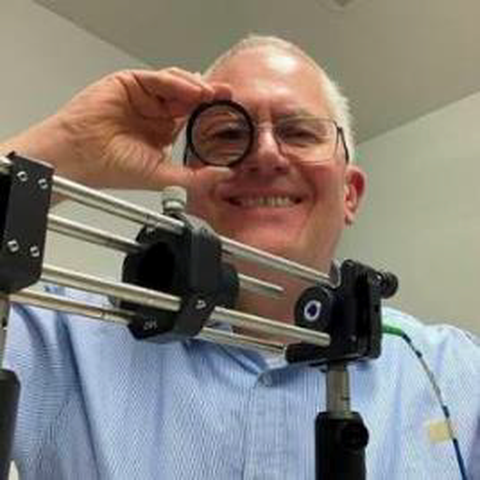Reinhart Koselleck–Projekt
Extraordinary success for the Faculty Electrical and Computer Engineering of TU Dresden: Another Reinhart Koselleck Excellence Project for Professor Juergen Czarske was approved.

Prof. Czarske in the lab
The Koselleck Project of the German Research Foundation (DFG) not only has substantial funding amount of €1,525,000, but especially offers considerable scope to pursue particularly innovative research with paradigm shifts and flexibility over 5 years. Although the new Koselleck Project is just beginning, Prof. Czarske was already honored for a Koselleck Project on a completely different topic, already in 2014. Two Koselleck Project Awards have been presented twice only in the history of the DFG.
The low-bureaucracy funding with global funds, which can be used flexibly for personnel, material, or capital expenditures, allows for extremely high freedom for innovative basic research. Reinhart Koselleck projects require not only a high-risk topic in the positive sense, but also an outstanding scientific CV. Prof. Juergen Czarske is a world-leading researcher in electro-optical systems engineering who has received prestigious international awards for his groundbreaking achievements, including the Joseph Fraunhofer Award / Robert M Burley Prize in Washington D.C. by OPTICA (Society for Advancing Optics and Photonics Worldwide, USA), the Laser Instrumentation Award of IEEE (Institute of Electrical and Electronics Engineers, USA), the Chandra S. Vikram Award in Optical Metrology, and the Dennis Gabor Award in Holography, both presented in San Diego by SPIE (International Society of Optics and Photonics, USA).
The Reinhart Koselleck project "Physics-Informed Deep Learning Systems for Secure Information Transmission with Multimode Fibers" is really not about the common suppressing of light scattering for distortion-free information transmission with single-mode fibers, but rather about to exploit the scattering in multimode-fibers. This new approach encompasses artificial intelligence (AI), physical modeling and explainable deep learning, computational imaging, neuromorphic computing, metamaterials/nanotechnology, and second-generation quantum technology. Physics-informed deep learning systems are increasingly proving to be a universally applicable Swiss Army knife for applications such as optical communication and sensing, automated driving, intelligent (endo)-microscopy for clinics and biomedicine, virtual reality (VR), augmented reality (AR) / metaverse, advanced manufacturing / production technology, quantum communication, quantum imaging, and quantum computing.
Within this Koselleck project, Prof. Czarske, together with an interdisciplinary team, aims to introduce a radically new paradigm for scattering media such as multimode fibers: the use of AI to explore and exploit light scattering, which not only corrects distortions but also enables the scattering itself to be used as a security code (Physical Layer Security). The risk of the project lies in precise measurements of complex linear and nonlinear scattering processes in fibers, which can also change rapidly. However, if this challenge is met, fundamentally novel applications will arise not only for classical and quantum communication, but also for biomedicine, such as fiber endoscopes for understanding the physics of life (PoL). However, there is considerable uncertainty as to whether this transfer from AI methods to quantum methods is even possible, which is why this research topic can only be investigated within the framework of the Koselleck project and not with conventional project funding. Furthermore, international cooperation and an interdisciplinary team of experts from various disciplines, such as systems engineering, electrical engineering, physics, quantum technology, computer science, and biomedicine, working closely together over a long period of time, are required. While there is no guarantee of project success, with fundamental new approaches, a commitment to independent research over five years, as well as diligence, perseverance, and an excellent team, paradigm shifts can be achieved, and sensational breakthroughs at Terra incognita can happen. An exciting time has started.
https://digitalhealth.tu-dresden.de/second-reinhart-koselleck-project-for-prof-jurgen-czarske/
https://ahmt.de/ahmt-mitglied-erhaelt-ein-reinhart-koselleck-projekt-der-deutschen-forschungsgemeinschaft-dfg/
https://www.juraforum.de/news/erfolg-im-reinhart-koselleck-programm-der-dfg-tud-prof-czarske-wirbt-renommierte-forschungsfoerderung-ein_266979
https://tu-dresden.de/tu-dresden/newsportal/news/erfolg-im-reinhart-koselleck-programm-der-dfg-tud-professur-juergen-czarske-wirbt-renommierte-forschungsfoerderung-ueber-rund-1-5-millionen-euro-ein?set_language=en
https://idw-online.de/en/news856252
https://tu-dresden.de/forschung-transfer/news/erneut-reinhart-koselleck-projekt-fuer-prof-juergen-czarske
https://www.dfg.de/de/foerderung/foerdermoeglichkeiten/programme/einzelfoerderung/reinhart-koselleck-projekte
https://tu-dresden.de/ing/elektrotechnik/iee/mst/die-professur/Auszeichnungen/reinhart-koselleck-projekt
https://6g-life.de/reinhart-koselleck-excellence-project-for-professor-juergen-czarske/
https://news.semivoice.com/post/377ba07840
https://news.semivoice.com/post/377ba07840
https://www.linkedin.com/posts/tu-dresden_success-in-the-dfgs-reinhart-koselleck-program-activity-7356678003692642304-n3De/
